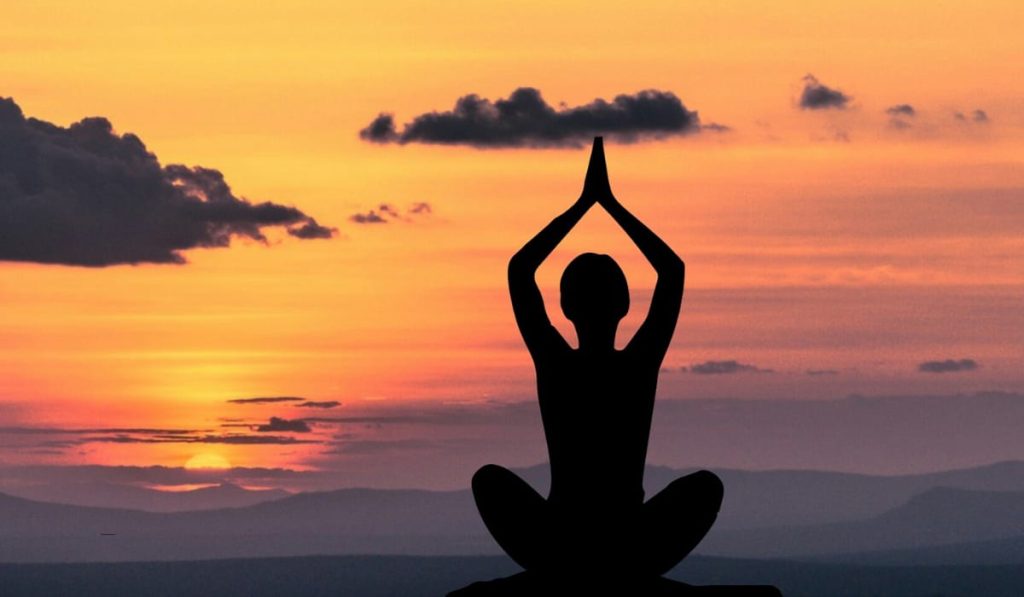Here are the list of precaution for practicing yoga asanas:
1) Śauca (cleanliness) – Cleanliness or purity is an important requirement for Yoga practice. It embraces the cleanliness of the environment, body, and mind.
2) Asanas and pranayama should be practiced on an empty stomach. If you feel hungry or weak, consume a little bit of fruit or juice or some liquid like a small amount of honey in lukewarm water, etc.
3) Emptying the bladder and bowels before starting Yogic practices gives wonderful benefits.
4) Practice periods should commence with Aum chanting and a prayer or an invocation as it generates a conducive setting to calm down the mind.
5) Yogic practices should be carried out slowly, in a relaxed peaceful mode, with mindfulness of the body, breath, and activities.
6) A joint exercise, subtle exercise, warm up or loosening exercise, and stretches before yoga- asanas are obligatory to avoid damage.
7) Slowly performing asana will allow you to progress to more difficult asana with time.
8) Satvik food helps to reach the depth of yoga. Avoid non-veg food, eggs, junk food, canned food, processed food, etc.
9) Before beginning your yoga practice, remain hydrated.
10) Dress in comfortable and supportive clothes. To allow for ease of body movement, cotton garments or other light and comfy clothes should be used.
11) Yoga should be practiced in a place with good ventilation and a gentle breeze.
12) When practicing yoga asana, use a mat with a good grip.
13) While performing yoga poses, be mindful of your breathing.
14) After yoga practice, use relaxation techniques like savasana to wind down.
15) Except when specially instructed to do so during the practice, do not hold your breath
16) Unless specifically taught differently, breathing should always be done through the nose.
17) Avoid overly tightening the body or jerking it violently.
18) Perform the yoga-asana to the best of your ability. Good results take time to achieve, so perseverance and frequent practice are crucial.
19) Some of the yoga poses have restrictions and contra-indications, and these contra-indications should constantly be kept in mind.
20) An effective yoga practice should conclude with savasana and finally meditation, prolonged silence or Sankalpa or Śānti pāṭha, etc.
21) The Yamas and Niyamas are yoga’s ethical principles and practices that are outlined in the first two limbs of Patanjali’s eightfold path. Together, they provide a moral code of behavior for the spiritual seeker.
The Yamas or restraints include Ahiṃsā (Nonviolence); Satya (Truthfulness); Asteya (Not stealing); Brahmacharya (Marital fidelity, sexual restraint); Aparigraha ( Non-avarice, non-possessiveness). Other attributes such as Patience, forgiveness, Fortitude, perseverance with the aim to reach the goal, Compassion, Non-hypocrisy, sincerity, Measured diet, etc. are also to be implemented.
The niyamas are behaviors or rituals to follow. They include-
- Śauca (Wholesomeness, Pureness of mind, speech, and body);
- Santoṣa (Contentment, satisfaction, acceptance of others and of one’s circumstances as they are, optimism for self)
- Tapah (Austerity, self-discipline- insistent meditation, persistence)
- Svādhyāya (Study of self, self-reflection, introspection of own feelings, speeches, and activities)
- Īśvarapraṇidhāna- Observation of the Ishvara (God/ Absolute Being, highest consciousness).
Some important tips to be followed while practicing an asana (third limb of yoga):
- Do not do asana without vinyasa. Here Vinyasa means careful linkage of breath and body. This past is very essential.
- Always listen to your body while doing an asana. Try to experience the sensation of the body during the pose (asana)
iii. Whenever asana is intense, practice ujjyai breath, or long breath. Continue to observe your breath as well.
- Try to feel the inner energy vibrations during the asana.
- Feel the organs that are being engaged or stretched.
Some important tips to be followed while practicing a Pranayama (fourth limb of yoga):
- Do not do pranayama very forcefully.
- Duration of internal breath retention and external breath retention should be as long as you feel comfortable. Never try these activities beyond the limit of comfort.
iii. Empty abdomen is very important.
- If you are suffering from High blood pressure or heart-related problems take special precautions from the yoga expert.
Avoid
- Yoga should not be practiced when you are sick, exhausted, in a rush, or under intense stress.
- In case of recovery from surgery, fracture, or sprains consultation with professionals.
iii. Regular yoga practice, especially intense and inverted asanas, should be avoided by women during their periods. Instead, you could practice gentle and easy asanas, pranayama, and relaxation techniques.
- Avoid doing yoga right after eating. Wait until 2 to 3 hours following a substantial meal. After doing yoga, wait 30 minutes before taking a shower, drinking water, or eating.
- Asana can be avoided in confrontational and thrilling weather like too cold or humid, too hot, etc.
- Before yoga-asana practice, check with health professionals if you are pregnant, have serious diseases, have any injuries, etc.
For more blogs visit on our Nepal Yoga Home blog section.

